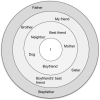Anorexia and Young Womens' Personal Networks: Size, Structure, and Kinship
- PMID: 35519652
- PMCID: PMC9063839
- DOI: 10.3389/fpsyg.2022.848774
Anorexia and Young Womens' Personal Networks: Size, Structure, and Kinship
Abstract
Anorexia is a serious threat to young women's wellbeing worldwide. The effectiveness of mental health intervention and treatment is often evaluated on the basis of changes in the personal networks; however, the development of such measures for young women with anorexia is constrained due to the lack of quantitative descriptions of their social networks. We aim to fill this substantial gap. In this paper, we identify the basic properties of these women's personal networks such as size, structure, and proportion of kin connections. The empirical analysis, using a concentric circles methodology, is based on 50 ego networks constructed on data drawn from interviews with Russian-speaking bloggers who have been diagnosed with anorexia and write about this condition. We conclude that young women with anorexia tend to support a limited number of social ties; they are prone to select women as alters, but do not have a preference to connect to their relatives. Further research is needed to elucidate whether these personal network characteristics are similar among women with anorexia who belong to different age, ethnic, cultural, and income groups.
Keywords: anorexia; mental health; networks; personal networks; young women.
Copyright © 2022 Mikhaylova and Dokuka.
Conflict of interest statement
The authors declare that the research was conducted in the absence of any commercial or financial relationships that could be construed as a potential conflict of interest.
Figures






Similar articles
-
Ethnic differences in women's use of mental health services: do social networks play a role? Findings from a national survey.Ethn Health. 2018 Apr;23(3):293-306. doi: 10.1080/13557858.2016.1263283. Epub 2016 Nov 28. Ethn Health. 2018. PMID: 27892690
-
Innovation diffusion: how homogenous networks influence the uptake of community-based injectable contraceptives.BMC Public Health. 2019 Nov 14;19(1):1520. doi: 10.1186/s12889-019-7819-5. BMC Public Health. 2019. PMID: 31727032 Free PMC article.
-
Difficult People: Who Is Perceived to Be Demanding in Personal Networks and Why Are They There?Am Sociol Rev. 2018 Feb;83(1):111-142. doi: 10.1177/0003122417737951. Epub 2017 Oct 31. Am Sociol Rev. 2018. PMID: 29749973 Free PMC article.
-
Impact of social protection on gender equality in low- and middle-income countries: A systematic review of reviews.Campbell Syst Rev. 2022 May 25;18(2):e1240. doi: 10.1002/cl2.1240. eCollection 2022 Jun. Campbell Syst Rev. 2022. PMID: 36913187 Free PMC article. Review.
-
Support provided by elderly in Italy: a hierarchical analysis of ego networks controlling for alter-overlapping.Stat Methods Appt. 2022;31(1):133-158. doi: 10.1007/s10260-021-00565-7. Epub 2021 Apr 20. Stat Methods Appt. 2022. PMID: 33897316 Free PMC article. Review.
Cited by
-
The Impact of Anorexia Nervosa and the Basis for Non-Pharmacological Interventions.Nutrients. 2023 Jun 1;15(11):2594. doi: 10.3390/nu15112594. Nutrients. 2023. PMID: 37299557 Free PMC article. Review.
References
-
- Aeby G., Gauthier J.-A., Widmer E. D. (2020). Patterns of support and conflict relationships in personal networks and perceived stress. Curr. Sociol. 2020:926.
-
- Aeby G., Widmer E. D., Česnuitytė V., Gouveia R. (2018). “Mapping the Plurality of Personal Configurations,” in Families and Personal Networks: An International Comparative Perspective Palgrave Macmillan Studies in Family and Intimate Life, eds Wall K., Widmer E. D., Gauthier J., Gouveia R. (London: Palgrave Macmillan; ), 131–166. 10.1057/978-1-349-95263-2_5 - DOI
-
- Albano G., Bonfanti R. C., Gullo S., Salerno L., Lo Coco G. (2021). The psychological impact of COVID-19 on people suffering from dysfunctional eating behaviours: a linguistic analysis of the contents shared in an online community during the lockdown. Res. Psychother. 24:557. 10.4081/ripppo.2021.557 - DOI - PMC - PubMed
LinkOut - more resources
Full Text Sources
Miscellaneous

